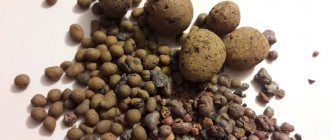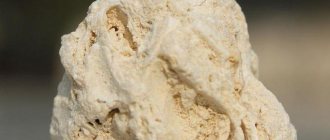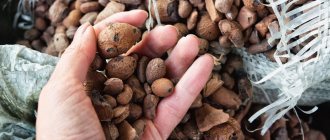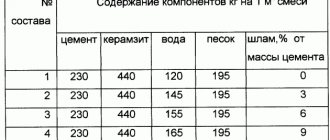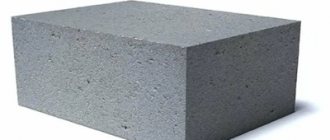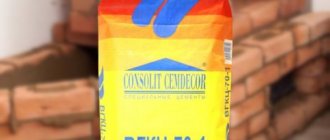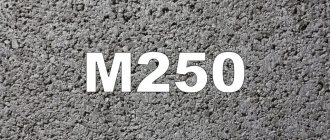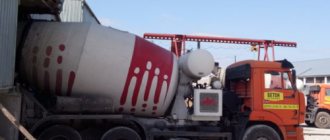Expanded clay is a popular material that is quite in demand in the world of modern construction technologies. To understand where and how best to use it in private housing construction, let’s consider the pros and cons of expanded clay, its classification and labeling, manufacturing methods, transportation rules and methods of application.
Its use depends on the type of expanded clay Source 5144102.ru
Advantages and disadvantages
The undoubted advantage of expanded clay is its low price. The completely budgetary cost of the material is the result of processing cheap raw materials - clay slate or pure clay. Other advantages of expanded clay include the following:
- high strength: thanks to its structure, it can easily withstand significant loads;
- resistance to temperature changes: expanded clay does not collapse and does not lose its properties in a wide temperature range: from -50°C to + 50°C;
- excellent noise insulation qualities allow the material to be used in the construction of sports or musical facilities;
resistance to temperature or chemical influences.
Floor insulation with expanded clay Source hochu-stroitsya.ru
The disadvantages of the substance include dust formation: you should only work with this material in enclosed spaces using a respirator. Another problem is high moisture permeability: the porous structure of expanded clay absorbs water, but is extremely reluctant to part with it. But these disadvantages are offset by the advantages of expanded clay: it is difficult to imagine a replacement for this material in terms of cost, ease of use and range of applications.
Expanded clay crushed stone - what is it
In terms of technical indicators, we will not see much difference between gravel and crushed stone. The same heavy-duty, resistant to aggressive environments, with low thermal conductivity. The difference is only visual - the shape of the grain is angular, the mass is not homogeneous. But, precisely because of its angular shape, crushed stone has better adhesion in concrete mortar when making ceramic concrete. Its use is a priority over gravel.
Concrete products using expanded clay crushed stone are light weight, high strength, and have low thermal conductivity.
This type of expanded clay is not indicated for use for pouring and screeding indoor floors. Its heterogeneous mass will not allow for a smooth surface; it is practically impossible to compact it tightly and level it. There are quite possible voids in the mass, which will certainly lead to cracks in the floor and this will be problematic to repair. Because the main covering will lie on top - tiles, laminate, carpet...
Expanded clay crushed stone is successfully used for insulation of heating mains, waterproofing of pipelines, soil drainage to maintain oxygen and air balance.
Classification and labeling
After processing, expanded clay is sorted. Based on the parameters of the final granules, the material is sorted into the following types:
- gravel: it is round granules without sharp corners, 5 – 40 mm in size, brown or red-brown in color;
- crushed stone: acute-angled fractions, size 5-40 mm. Sharp corners significantly narrow the scope of gravel; crushed stone is used in concrete mixtures;
- sand: granule diameter up to 5 mm. It appears as a by-product of the main production. This sand is used as filler.
Expanded clay is marked according to the grain size of the fractions. Granules are distinguished with sizes of 5-10 mm, 10-20 mm, and so on. An error of 5% is allowed, that is, in a bag with granules of a certain size you can find a small amount of expanded clay of other fractions.
Expanded clay packaging with marking Source plpstatic.ru
The material is also distinguished by bulk density. So, grade 450 will mean that a cubic meter of this material will weigh 450 kg.
Other designs
There are different crushers, their main difference from each other is the processed material. There is a fundamental difference between a machine that shreds cardboard or foam rubber, and a machine that is suitable for rubber (tires, tires) or, for example, expanded clay. Crushers are also made to crush bird bones. You can make a glass grinding machine yourself.
Use elements of used equipment: washing machine, meat grinder, grinder, etc. The main thing is that the principle of operation of the device is observed . Figuratively speaking, this is the principle of a meat grinder, in which the material passes through the drum/reception bowl, ends up in the crushing system and is effectively crushed. The department where the material is ground is represented by cutters and a milling cutter. The raw material will be processed until it reaches the required grinding size.
For example, until it becomes metal shavings or sawdust
With the help of a gear-rotor crusher you can crush even asphalt and clay. The roller system is most often used for grain processing. And there are a great many examples of such structures. But if you look at the step-by-step instructions for making a garden crusher, a device for any other material will be made according to the same basic plan. Only its power, size, number of saws, etc. will change.
See the video below for options for making a crusher with your own hands.
Source
Technical properties
Let's take a closer look at the characteristics of expanded clay.
- Strength. This characteristic directly depends on the composition of the feedstock and the size of the fractions. The less porosity of the material, the stronger it is.
- Compaction coefficient - taken into account when storing and selling building materials. This parameter for expanded clay should not exceed 1.15.
- The thermal conductivity of expanded clay is in the range of 0.1-0.18 W/meter (at 0°C). Expanded clay with a thickness of 25 cm retains as much heat as an 18-centimeter thick polystyrene foam crust. The more holes in the granules, the higher the thermal insulation qualities of this insulation.
- Moisture absorption. The proportion of water in its composition can reach 20% if stored improperly. Insulation with a burnt crust allows less moisture to pass through. The more water in expanded clay, the faster it loses its thermal insulation properties.
Dry expanded clay Source userapi.com
- Noise insulation. Expanded clay has excellent soundproofing properties, so it is often used in the construction of interfloor and interior floors.
- Fire safety. Expanded clay is a good insulator. It is non-flammable and chemically inert.
- Heat resistance Expanded clay granules tolerate temperature changes well and can be stored for a long time in frosty open air. The main condition is to keep the material away from water. At high humidity, expanded clay can be destroyed due to freezing of water in its holes.
Among other properties of expanded clay, buyers highlight the low cost of this material and the safety of its use - both for humans and for the environment.
Expanded clay is an environmentally friendly material Source ogorod.ua
See also: Catalog of companies that specialize in home insulation
We are planning to make the blocks ourselves - we are preparing materials and tools
Having decided to make expanded clay blocks with your own hands, prepare the necessary materials, working tools and equipment for the production of composite blocks:
- ingredients for preparing expanded clay concrete mortar;
- concrete mixer for mixing components;
- shovels and buckets for loading raw materials into a concrete mixer;
- vibrating table for effective compaction of the mixture.
You will also need collapsible formwork for single or group pouring of products. It is easy to make molds for expanded clay concrete blocks with your own hands from sheet metal, laminated plywood or wood.
How is expanded clay made?
Clay is a unique building material, known since ancient times. The word “expanded clay” itself was known to the ancient Greeks, and it is translated as “burnt clay.” For thousands of years, the technology for producing expanded clay has remained virtually unchanged. The raw materials are subjected to sudden temperature changes, which causes pores to appear in the clay, and then it easily crumbles into small granules.
The best raw materials are clays, which contain up to 30% quartz. Sometimes metamorphic rocks with a complex composition are used, which also include clay minerals such as feldspar, micas and various impurities.
To produce expanded clay, raw materials must meet the following requirements:
- fusibility;
- the ability to swell when foaming;
- fast swelling speed.
Expanded clay production: stages of production Source toolbox-site.com
The result of processing the raw material mixture is raw granules of various parameters, which are subsequently dried, fired and cooled. At the final stage of production, expanded clay is sorted according to the parameters and density of each granule. If the granules are too large, they are crushed into small fractions. The finished building material is packaged and stored.
A mini-factory will help you make expanded clay at home. The raw material for homemade expanded clay is expanded clay sand, which is obtained by crushing substandard gravel, and the fuel can be fuel oil, natural gas or coal.
The mini-plant produces expanded clay granules up to 5 mm in size. In this case, any fuel can serve as fuel - from coal to fuel oil. When producing large volumes of material, it is advisable to purchase a crusher that crushes the source material and significantly simplifies production. At home, you can set up the production of granules and produce expanded clay with a volume of up to 30 thousand cubic meters. m per year. You can judge what expanded clay looks like from this photo:
Types of expanded clay Source sazhaemvsadu.ru
Extraction of feedstock
The production process begins with the extraction of raw material by quarrying and its transportation to clay reserves. Development is carried out in an open way, using single- and multi-bucket excavators. Individual layers are not identified; production occurs throughout the entire height.
When extracting stone-like rocks in the form of mudstone and clay shales, drilling and blasting operations are used. Such breeds can be developed at any time of the year, while soft breeds can only be developed during the appropriate period.
To ensure that the production process continues uninterruptedly, special frost-resistant clay storage facilities are built to hold a six-month supply of raw materials. You can use intermediate cones for storage, in which the clay is kept in the open air for several months.
Production of expanded clay
Under the influence of temperature, periodic wetting and drying, the structural structure of the raw material is partially disrupted, which significantly facilitates the process of its subsequent processing into a homogeneous mass.
Storage and transportation
No special conditions are required for storage and transportation of this material. Expanded clay is stored in packaged form, in warehouses or outdoors, under a canopy. This prevents damage and contamination. Expanded clay is protected from water, since when moisture gets into the pores of the material, its strength noticeably decreases.
Transportation of expanded clay is consistent with GOST 25880; it can be transported packaged or in bulk. For transportation, ships (barges), rail and road transport are used. Loading is carried out in clean containers, without the remains of previously transported goods. Loading and unloading is carried out with minimal mechanical impact to prevent the destruction of granules. Ingress of water, dirt, and loss of cargo are excluded.
Storage and transportation of expanded clay Source keramzitspb.ru
Material that is not currently used in construction should be covered with a waterproof coating and sides constructed. It is advisable to lay slate, roofing felt, and roofing iron underneath.
Cooling of granules
After firing, expanded clay should be cooled. Cooling begins already in the rotary kiln, thanks to the incoming air. Then it continues in air chutes, drum refrigerators, etc.
The strength of the material depends on how quickly the granules are cooled. If cooling occurs too quickly, the granules may crack. With slow cooling, the quality of the material may decrease as a result of softening and crushing of the granules.
Therefore, expanded clay is cooled to 800-900 degrees immediately after swelling. After this, cool to 600-700 degrees for 20 minutes.
This is necessary so that hardening occurs without high thermal stress, and crystalline minerals are formed, which increase the strength properties of the material. Further cooling can be done quite quickly.
Expanded clay in construction
The properties of expanded clay make it an indispensable material for insulating exterior and interior walls and floors. Let's look at just some of the ways to use expanded clay in construction.
Floor screed
The use of expanded clay when screeding a floor can significantly reduce the load on supporting structures. The work is completed in two days, resulting in a perfectly flat floor with high noise-absorbing properties.
The work process is as follows:
- the floor and bottom of the walls (5-10 cm) are cleaned and covered with polyethylene;
- A layer of expanded clay is poured onto the film. The larger the size of the granules, the lower the density of the layer and the less pressure on the supporting structures;
- expanded clay is filled with a thin layer of liquid cement;
- After complete drying (48 hours), proceed to screed the floor.
Expanded clay screed Source pol-inform.ru
Thermal insulation work
Insulation with expanded clay is carried out using a similar technology. If a wooden floor is being insulated, then there is no need to fill the expanded clay layer with cement: the floor is simply covered with boards on top. An additional advantage of this method: rodents and harmful insects do not grow in the expanded clay layer.
Foundation insulation
Foundation insulation can be carried out both inside and outside the building. During external work on insulating the foundation, expanded clay gravel is used to fill the empty space under the blind area from the yard. When insulating the inside of a building, work is carried out under the ceiling of the first floor.
Important! It should be remembered that the main enemy of expanded clay is moisture, therefore, with any insulation, the expanded clay layer should be protected with good waterproofing.
Wall insulation
Insulation with expanded clay is most often done using the three-layer masonry method. To do this, you will need expanded clay concrete blocks, which are made from a mixture of expanded clay, sand, cement and water. The insulation technology comes down to the following:
- the supporting layer is laid out from expanded clay concrete blocks;
- to lay the base layer, make a solution of cement laitance and expanded clay (capsimet);
- The protective layer consists of facing materials that protect the base layer from moisture.
Features of manufacturing technology
Technology
*
To form expanded clay, you need a material with the following qualities:
- change in volume during firing;
- fusibility;
- strength.
To facilitate the swelling process, additional components can be added, including fuel oil, diesel fuel or perlite.
Granules of a certain size with established characteristics are formed. They are then dried and fired to impart strength and hardness. After firing, all granules must be thoroughly dried.
In the production process, special attention is paid to sorting. It includes work on separating granules by size, as well as breaking large fractions into smaller ones. Upon completion of all procedures, expanded clay is packed into bags or bags and prepared for shipment.
Thus, expanded clay is obtained as a result of swelling of the clay structure, which turns into porous granules with a hard shell.
Use of expanded clay in other fields of activity
Construction is far from the only area of application for expanded clay granules. This material is often used to cover garden paths in summer cottages. Expanded clay is laid as the first layer that comes into contact with the ground. The standard installation diagram can be seen in the figure:
Garden paths on expanded clay Source samdizajner.ru
Expanded clay paths remain dry even after heavy rainfall. Dirt does not accumulate on them, they are easy to clean, and if necessary, such a path can be easily moved to a new place.
Expanded clay is often used for mulching the soil, and in this capacity it is used both in gardening and in growing indoor plants.
The use of expanded clay in landscape design is also known. Bright granules favorably set off the greenery of the park. Expanded clay crushed stone is used to fill voids in alpine slides, level the surface of flower beds, and fill the soil for less water consumption. And if someone thinks that the brown color is quite boring, do not be upset: currently, expanded clay is sold in stores in various colors, and it will not be difficult to choose the right shade.
Decorating with expanded clay Source aviarydecor.com
Step-by-step instructions for creating a garden model
Every gardener knows what spring pruning of trees is. And he knows that after it a new problem appears - where to put the branches. You can make compost out of them, of course, but there is a way to get it much faster than just throwing the branches (as they are) into the compost pile. They just need to be crushed, then the compost can ripen within a season, or even faster.
To build a garden shredder you need to prepare:
Once everything is in front of you, you can move on to the creation process itself.
What’s good about a homemade shredder is its reliability and operation, as they say, without undue embarrassment. It will do an excellent job with the same branches, and with other household garbage, and crushing fruits (directly with seeds). Finally, self-production is also a matter of saving. A homemade product, even if it breaks at some point, will not require the purchase of a specific expensive part (as will happen with a store-bought crusher); it can be repaired with something readily available, inexpensive, and available on the farm.
